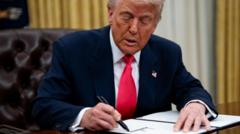The order aims to decentralize education funding, igniting intense debates and legal hurdles ahead.
**Trump Moves to Dismantle Education Department with Bold Executive Order**

**Trump Moves to Dismantle Education Department with Bold Executive Order**
In a sweeping executive move, President Trump takes steps to close the U.S. Department of Education, reiterating long-held conservative desires.
On Thursday, President Donald Trump signed a significant executive order that seeks to dismantle the Department of Education, fulfilling a campaign promise that has resonated with many conservatives for decades. The president criticized the agency for its "breath-taking failures," pledging to redirect the agency's budget back to the states. “We’re going to shut it down as quickly as possible,” Trump stated, even as White House officials acknowledged that an outright closure would necessitate congressional approval.
The Department of Education was established in 1979 and has primarily been responsible for administering student loans and supporting low-income educational initiatives. Contrary to some misconceptions, federal funds constitute only a fraction of school financing—around 13%. The majority of funding is sourced from state and local tax revenues, leading many to question the necessity of a federal education agency.
Trump’s criticism extended to what he termed the department's indoctrination of youth with politically charged ideas, especially concerning racial and sexual topics. During the executive order signing, attended by schoolchildren at the White House, the president reflected on educational spending. While he noted that the U.S. invests over 5% of its GDP into education—one of the highest rates globally—he pointed out that American students often rank disappointingly low compared to peers abroad.
Despite potential backlash, including legal challenges from education advocates and politicians who oppose drastic cuts, Trump aims to wield the authority over educational programs to state governments, effectively stripping the department of its power to enforce educational standards nationwide. Republican Senator Bill Cassidy quickly announced plans to introduce legislation for the closure, but such efforts face significant hurdles given the narrow Republican margin in the Senate.
Trump's executive order might not outline specific cuts to programs or staff reductions immediately; however, it does mandate the department's current head, Linda McMahon, to take all necessary measures for a swift closure. "This is our opportunity to perform one final, unforgettable public service to future generations of students," McMahon remarked in a memo to the agency’s workforce.
As the discussions unfold, prominent educators and union leaders have voiced strong opposition to the initiative, stressing the importance of federal support for marginalized students. The American Federation of Teachers implored the administration not to prioritize ideological battles over the needs of children living in poverty or with disabilities.
The move to dismantle the educational oversight has been a conservative dream dating back to Ronald Reagan’s presidency. Moreover, Trump’s administration has already enacted workforce cuts, affecting staff at the Department of Education as part of a larger strategy to streamline federal operations led by the Department of Government Efficiency.
While the future of education funding hangs in the balance, many are left wondering about the overarching implications of such a monumental shift and the potential for unintended consequences on academic accessibility and quality across the nation.
The Department of Education was established in 1979 and has primarily been responsible for administering student loans and supporting low-income educational initiatives. Contrary to some misconceptions, federal funds constitute only a fraction of school financing—around 13%. The majority of funding is sourced from state and local tax revenues, leading many to question the necessity of a federal education agency.
Trump’s criticism extended to what he termed the department's indoctrination of youth with politically charged ideas, especially concerning racial and sexual topics. During the executive order signing, attended by schoolchildren at the White House, the president reflected on educational spending. While he noted that the U.S. invests over 5% of its GDP into education—one of the highest rates globally—he pointed out that American students often rank disappointingly low compared to peers abroad.
Despite potential backlash, including legal challenges from education advocates and politicians who oppose drastic cuts, Trump aims to wield the authority over educational programs to state governments, effectively stripping the department of its power to enforce educational standards nationwide. Republican Senator Bill Cassidy quickly announced plans to introduce legislation for the closure, but such efforts face significant hurdles given the narrow Republican margin in the Senate.
Trump's executive order might not outline specific cuts to programs or staff reductions immediately; however, it does mandate the department's current head, Linda McMahon, to take all necessary measures for a swift closure. "This is our opportunity to perform one final, unforgettable public service to future generations of students," McMahon remarked in a memo to the agency’s workforce.
As the discussions unfold, prominent educators and union leaders have voiced strong opposition to the initiative, stressing the importance of federal support for marginalized students. The American Federation of Teachers implored the administration not to prioritize ideological battles over the needs of children living in poverty or with disabilities.
The move to dismantle the educational oversight has been a conservative dream dating back to Ronald Reagan’s presidency. Moreover, Trump’s administration has already enacted workforce cuts, affecting staff at the Department of Education as part of a larger strategy to streamline federal operations led by the Department of Government Efficiency.
While the future of education funding hangs in the balance, many are left wondering about the overarching implications of such a monumental shift and the potential for unintended consequences on academic accessibility and quality across the nation.




















